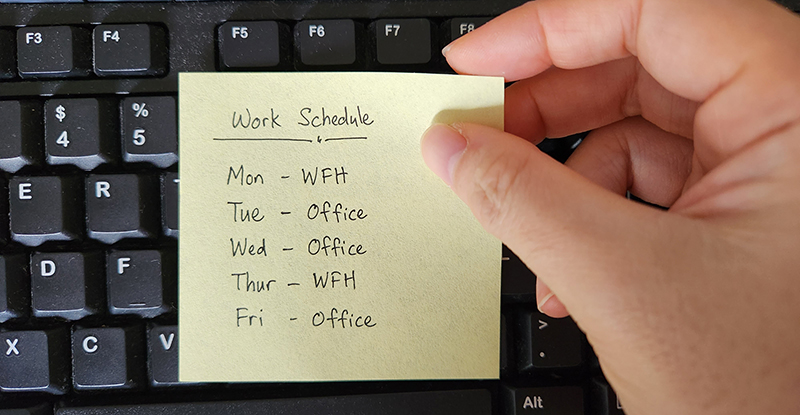
Longer hours. More emails. First-time projects. New tech. During the switch to remote, then hybrid work, these efforts enabled many teams to maintain or even improve their productivity. Now, with hybrid work being the norm at many organizations, how can teams ensure they continue to thrive?
Here are some ways organizations can help teams cultivate a healthy, productive – and happy – hybrid culture.
Watch out for these productivity drains
Silos: Some of the biggest productivity challenges for hybrid teams occur when people operate in silos and are disconnected. Trust and connections require maintenance and effort. Without these crucial connections, teammates might not be sharing information about common projects, or collaborating enough to achieve common goals. Hybrid teammates need to be very deliberate about connecting with one another and there are many ways to do this. Try a virtual coffee, share your challenges and successes with your leader, proactively network with people in your department, or reach out to a colleague to offer your support.
Digital burnout: When everyone was in the office it was easy to pass someone in the hall and have a chat. Now we're having more video calls and email volume is going up. To avoid digital burnout, we need to remember to take a break from the screen and call the person you’re working with. As well, daytime breaks and clear boundaries between work and personal time will help you get away from your screen and avoid digital burnout.
Facetime bias: This bias favours people working in the office who can be perceived as more hardworking and committed. We can mitigate facetime bias by being more deliberate about how we share opportunities with people who are in the office versus virtual, and about how we recognize work. Leaders also need to be conscious about making sure they understand and recognize what their virtual colleagues are doing to contribute to team goals.
Revisit email etiquette
For the sake of clarity and keeping everyone on the same page, over-communication has always been important. It is even more important with hybrid teams to make sure we have transparency and equal access to key messages. But in our efforts to communicate with our hybrid team members, email volume has gone up and people are feeling overwhelmed by it all. So, how do we reconcile this?
Adopt some good email hygiene and email team norms. One helpful email team norm is to avoid using email for conversations. Think about the following scenario – if I have a question for you, I could send you an email. You might send me an answer back, but with some additional questions. I’ll respond back to you, and now we’ve gone back and forth three times. At this point, it's time to pick up the phone – it's a conversation. Email is for information transfer, not for conversations.
Keep emails brief and proofread for clarity. When you have a lot of information to share, an email can quickly grow. Going back to edit it requires an extra step that we can be tempted to skip. But this doesn’t ensure good communication. People are busy, so brief and clear emails are essential. After writing an email, review it to make sure your message is easy to understand and trim any words that aren’t necessary.
Copying everyone under the sun? It’s time to stop. A great technique is to take some people off of the email string, or to thank them for their contributions and note you're moving them into the BCC line so they are removed from future email strings.
Don't expect instantaneous responses. If you need someone instantly, call them or text them. Email is designed to be an asynchronous tool. If leaders expect their team to respond to emails instantly, they are not supporting a work environment where team members can get focused, value-added work done. Instead, identify reasonable response time expectations across your team – the kind that also allow people time to focus in meetings or focus on their other work.
Hybrid meetings
Meetings come with many challenges in the hybrid work environment. To have effective hybrid meetings, we want to be very deliberate about how we run them and below are some pointers to help achieve this goal.
Investing in technology is key. The right technology allows us to make sure everyone can see and hear each other in a relatively equal format. Having one webcam per participant enables virtual attendees to see all in-person attendees clearly and at the same size. Also try to avoid using physical flip charts; instead, use virtual flip charts and meeting materials to allow everyone an opportunity to make an equal contribution.
Meeting facilitators should turn to virtual attendees first when recruiting input. Virtual attendees tend to get forgotten, so call out to them by name because it is harder for them to cut into an in-room conversation. During breakouts, combine in-person and virtual meeting attendees.
Start the meeting at the same time for everyone. Avoid the scenario where in-person attendees spend the first few minutes of the meeting chatting with each other before starting the video call. Instead, start the meeting for everyone at the same time and pull the online attendees into the casual chitchat. This will allow all team members to connect with each other.
As more of us become hybrid workers, being conscious about how we’re working, communicating, and meeting with each other is the key to help us stay productive and to thrive in this new working environment.
Author
Ann Gomez is an engaging speaker and the founding president of Clear Concept Inc. She is passionate about empowering the world’s busiest people to perform at their best. She is also the best-selling author of "The Email Warrior", an active blogger and media spokesperson.



